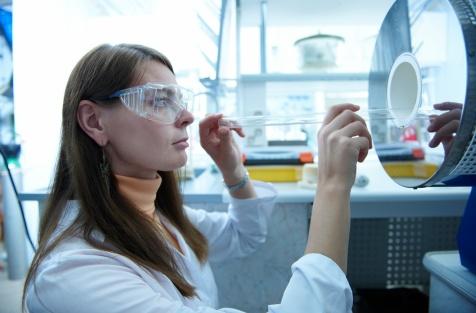Silver improves efficiency of kesterite solar cells

Estonian researchers improve efficiency of solar cells from 6.6 percent to 8.7 percent
As a result of a two-year joint project, materials researchers at Tallinn University of Technology in Estonia have improved the efficiency of next generation solar cells by partial substitution of copper with silver in absorber material. They published the results in the Journal of Materials Chemistry A.
The TalTech researchers are developing cells using an unusual compound semiconductor material called kesterite, a non-toxic competitor to perovskite with the formula Cu2ZnSn(Se,S)4,
To produce kesterites, TalTech researchers use a monograin powder technology, which they say is unique. "The monograin powder technology we are developing differs from other similar solar cell manufacturing technologies used in the world in terms of its method. Compared to vacuum evaporation or sputtering technologies, which are widely used to produce thin-film structures, the monograin powder technology is less expensive," explains Marit Kauk-Kuusik (pictured above), senior researcher at TalTech Laboratory of Photovoltaic Materials.
Powder growth involves heating the chemical components in a chamber furnace at 750degC for four days. Afterwards, the mass obtained is washed and sieved. The synthesised microcrystalline powder, monograin powder, is then used for the production of solar cells. The powder technology differs from other production methods in particular due to its low cost, since it does not require any expensive high vacuum equipment.
The monograin powder consists of microcrystals that form parallel connected miniature solar cells in a large module (covered with an ultra-thin buffer layer). The researchers saysthis provides major advantages for photovoltaic modules: the photovoltaics cells are lightweight, flexible, can be transparent, while being environmentally friendly and significantly less expensive that silicon technology.
The indicator of the quality of photovoltaics is the efficiency. Efficiency depends not only on the properties of the materials used and the structure of the solar cell, but also on solar radiation intensity, angle of incidence and temperature.
The ideal conditions for achieving the maximum efficiency are in cold sunny mountains, not in a hot desert, as one would expect, because heat does not improve solar cell's efficiency. It is possible to calculate the maximum theoretical efficiency for each solar panel, which, unfortunately, has so far been impossible to achieve in reality, but it is an objective to pursue.
"We have reached the point in our development where partial replacement of copper with silver in kesterite absorber materials can increase efficiency by 2 percent. This is because copper is highly mobile in nature, causing unstable solar cell efficiency. The replacement of 1 percent copper with silver improved the efficiency of monograin layer solar cells from 6.6 percent to 8.7 percent," Kauk-Kuusik says.
The monograin layer solar cell technology is implemented by the Estonian-Austrian joint venture Crystalsol GmbH. In order to commercialise the photovoltaic technology developed, the researchers think the solar cell efficiency should be increased to 15 percent.
'The effect of Ag alloying of Cu2(Zn,Cd)SnS4 on the monograin powder properties and solar cell performance' by Kristi Timmo et al; Journal of Materials Chemistry A, Issue 42, 2019


































